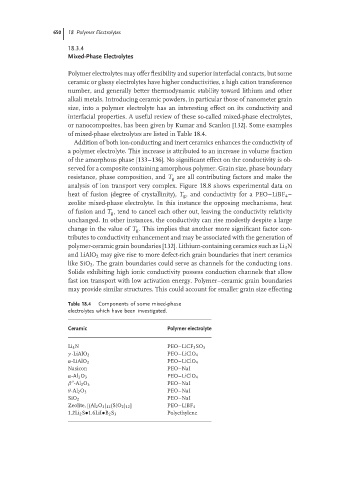Page 676 - Handbook of Battery Materials
P. 676
650 18 Polymer Electrolytes
18.3.4
Mixed-Phase Electrolytes
Polymer electrolytes may offer flexibility and superior interfacial contacts, but some
ceramic or glassy electrolytes have higher conductivities, a high cation transference
number, and generally better thermodynamic stability toward lithium and other
alkali metals. Introducing ceramic powders, in particular those of nanometer grain
size, into a polymer electrolyte has an interesting effect on its conductivity and
interfacial properties. A useful review of these so-called mixed-phase electrolytes,
or nanocomposites, has been given by Kumar and Scanlon [132]. Some examples
of mixed-phase electrolytes are listed in Table 18.4.
Addition of both ion-conducting and inert ceramics enhances the conductivity of
a polymer electrolyte. This increase is attributed to an increase in volume fraction
of the amorphous phase [133–136]. No significant effect on the conductivity is ob-
served for a composite containing amorphous polymer. Grain size, phase boundary
resistance, phase composition, and T g are all contributing factors and make the
analysis of ion transport very complex. Figure 18.8 shows experimental data on
heat of fusion (degree of crystallinity), T g , and conductivity for a PEO–LiBF 4 –
zeolite mixed-phase electrolyte. In this instance the opposing mechanisms, heat
of fusion and T g , tend to cancel each other out, leaving the conductivity relativity
unchanged. In other instances, the conductivity can rise modestly despite a large
change in the value of T g . This implies that another more significant factor con-
tributes to conductivity enhancement and may be associated with the generation of
polymer-ceramic grain boundaries [132]. Lithium-containing ceramics such as Li 3 N
and LiAlO 2 may give rise to more defect-rich grain boundaries that inert ceramics
like SiO 2 . The grain boundaries could serve as channels for the conducting ions.
Solids exhibiting high ionic conductivity possess conduction channels that allow
fast ion transport with low activation energy. Polymer–ceramic grain boundaries
may provide similar structures. This could account for smaller grain size effecting
Table 18.4 Components of some mixed-phase
electrolytes which have been investigated.
Ceramic Polymer electrolyte
Li 3 N PEO–LiCF 3 SO 3
γ -LiAlO 2 PEO–LiClO 4
α-LiAlO 2 PEO–LiClO 4
Nasicon PEO–NaI
α-Al 2 O 3 PEO–LiClO 4
PEO–NaI
β -Al 2 O 3
θ-Al 2 O 3 PEO–NaI
SiO 2 PEO–NaI
Zeolite, [(Al 2 O 3 ) 12 (SiO 2 ) 12 ] PEO–LiBF 4
1.2Li 2 S•1.6LiI•B 2 S 3 Polyethylene

